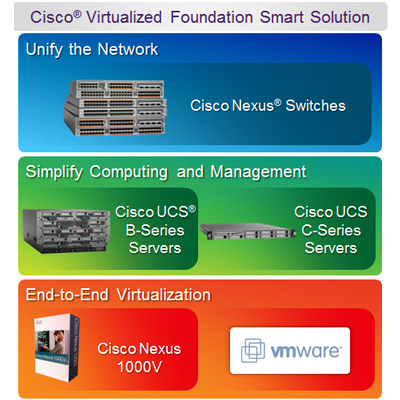Speed delivery of new applications and services
Solution Design Elements
The Cisco design approach includes three critical elements to create an IT architecture that's right-sized for midsize organizations. This design is fully integrated for optimal business agility and return on investment (ROI).

Unify the Network
The first design element of the Cisco solution is a unified network infrastructure. It helps reduce networking costs, provides reliable access to information, secures critical data, and facilitates management of growing data storage requirements. This consolidation creates a single, centrally manageable infrastructure which includes:
- Ethernet infrastructure
- Storage networking
- Network security
The core of this data center network is built with Cisco Nexus 5500 Series Switches. These integrate server and storage networks into a unified, highly secure, and resilient network foundation optimized for virtualized data centers.
Simplify Computing and Management
To attain the most efficient flexibility, scalability, and resilience from a virtualized IT infrastructure, the second design element optimizes computing resources with a single integrated architecture.
This unified architecture supports end-to-end server visibility, management, and control with a single point of management. It combines Cisco networking innovations, unified management, storage access, and industry-leading Intel Xeon x86-based processors in both blade and rack-mount server configurations.
The Cisco Unified Computing System (UCS) radically simplifies how users deploy and manage servers and networks, supporting rapid application growth and scalable business continuance capabilities.
Deploy End-to-End Virtualization
The third design element deploys virtualized networking components alongside server virtualization solutions from major vendors, for optimum flexibility and control. The integrated design reduces day-to-day operational complexity, compared to non-virtualized environments.
Virtualization technology simplifies management of the entire server room or data center. It decouples managed assets and services from the physical infrastructure and separates hardware management from software management. And it consolidates physical servers, storage, and networking components into a single asset pool.
End-users view resources as if they were dedicated to them. Administrators can manage and optimize resources to serve business requirements in minutes, instead of days. They can immediately allocate and reallocate resources to software services on demand.
You can transform the way that your network uses and manages devices. Follow these four steps to get started:
- Discover what Cisco can do for you: View a demonstration with your Cisco partner.
- Identify your requirements and use cases: Schedule an Architecture Strategy Workshop with your Cisco sales team or partner.
- Use Cisco design guides: These capture and codify extensive Cisco experience, to help ensure deployments that are faster, reliable, and predictable.
- Define the investment and rollout roadmap: Work with Cisco Services or partner to build the processes and timeline for your phased plan for an integrated network and data center. The Cisco Services team and Cisco partners can help your initiative be successful and deliver exceptional business benefits, on-time and on-budget.